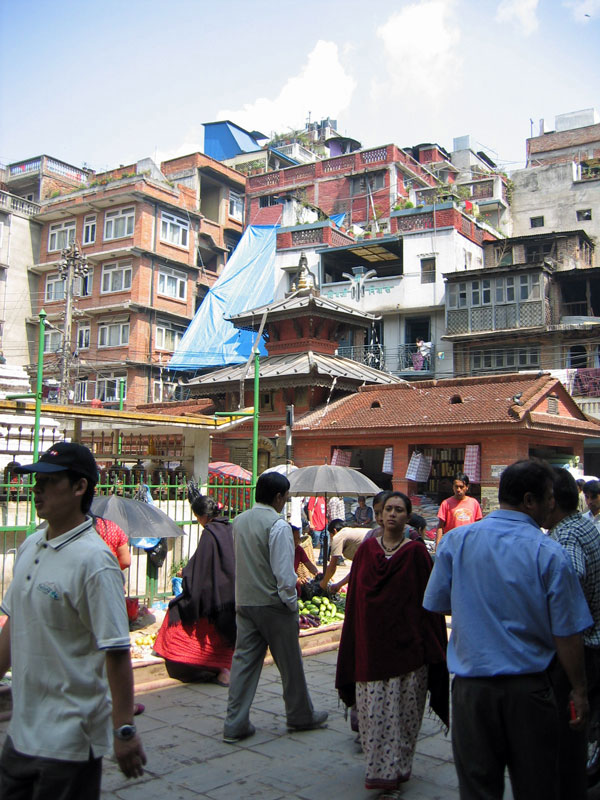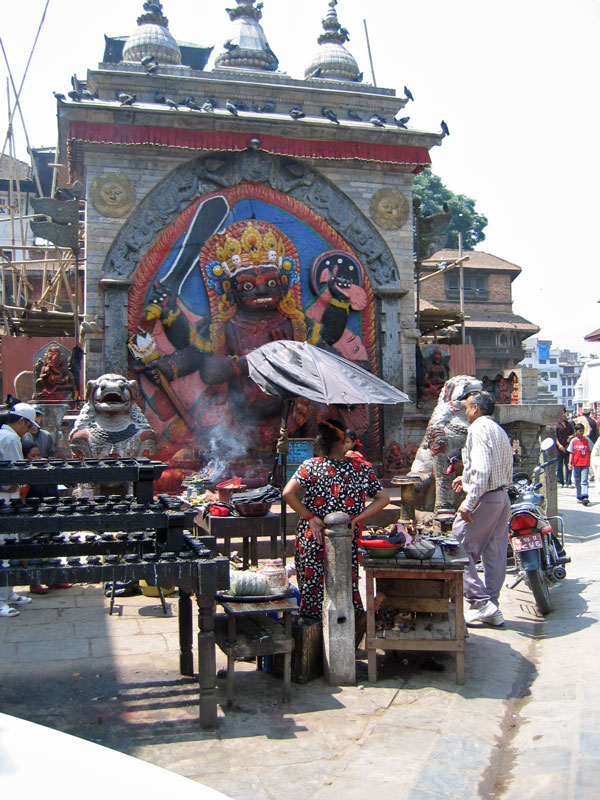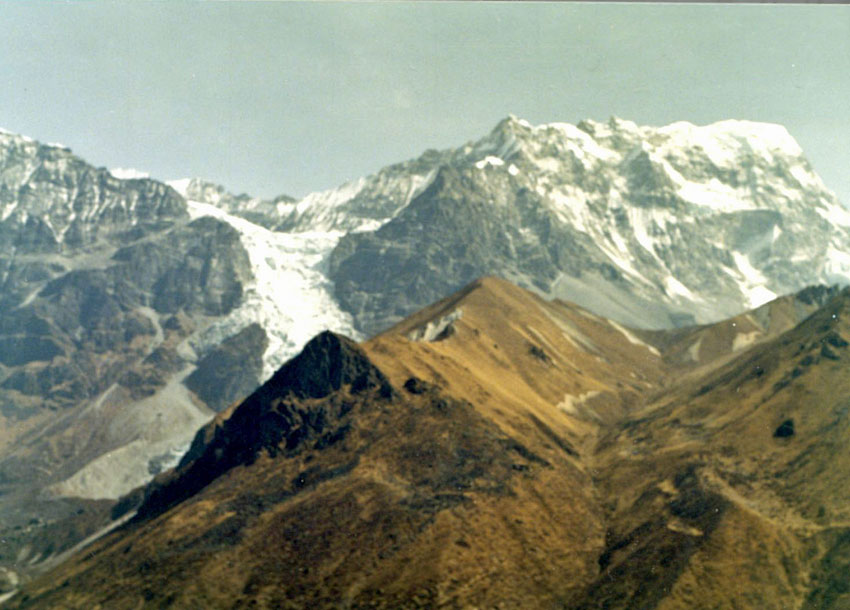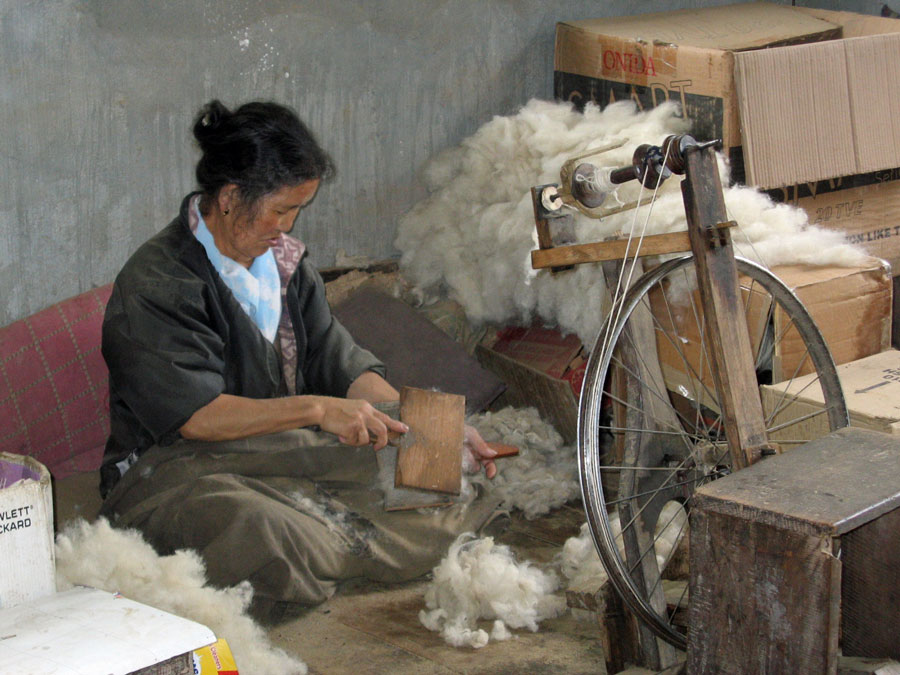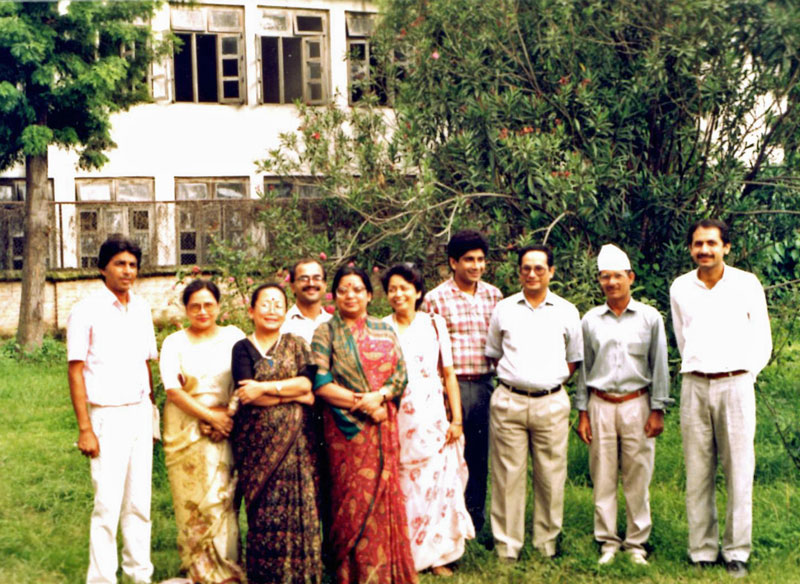Flying from Delhi to Kathmandu in September 1989, I sat next to a young Dutch couple. Like me, they were on a trekkers’ vacation. They had been to Nepal often, the man told me: “People always come back to this country.” A little more than two years later, I went back myself. My first stay had been too brief--one month cannot do justice to such a country.
Neither, as I discovered, can six a half months. This time, however, I was no longer a visitor but a true resident, living in Kathmandu, working there and, in a blundering but enjoyable fashion, speaking the language. For this privilege--which is exactly what it was--I must thank the Fulbright program. They had the perfect place for me: a term teaching American Literature in Kathmandu. To be sure, despite my month in 1989, I had little idea what I was getting into. I just knew that I wanted to go. So one bright January day I again landed at Tribhuvan airport, this time from Bangkok after a long flight over the Pacific.
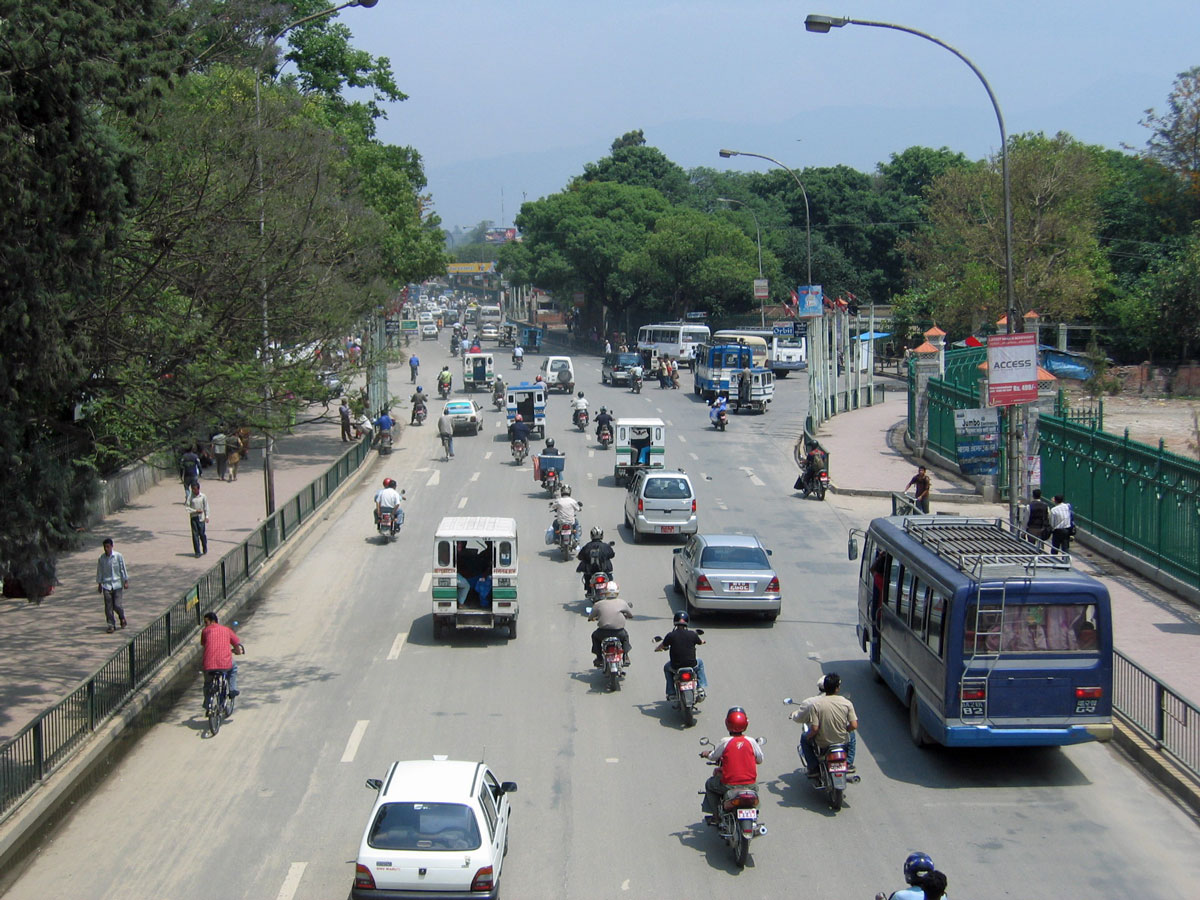
The Fulbright brochure had said that candidates should be “self-starters,” and I was soon to see why: the university was the most disorganized institution I had encountered, even after four years teaching in West Africa and many encounters with Brooklyn College registration. There was no college calendar--courses began and ended with the briefest of notice. Hundreds of students signed up for classes that could accommodate one-third their number, and political feuding culminated in literal brick-throwing. But whatever problems I encountered paled beside those of my Fulbright predecessor, Marilyn Callander, who had written me that I must have done something extremely worthy in some previous incarnation to follow rather than precede her as Fulbright Professor, as I was grandly styled. She had arrived some months before to find no teaching schedule and as soon as she began to arrange one the entire university went on vacation for October. But by the time I showed up, her American literature class was well under way.
Indeed I met Marilyn’s students within hours of my arrival. I went straight from the airport to the Fulbright house--still Marilyn’s, but to be mine a week later after Marilyn had returned to America. I was invited to one of Marilyn’s many farewell occasions: a dinner with her students. It was an invitation not to refuse, even though I was intruding on Marilyn’s glory. As in Africa, in Nepal hospitality is almost universal.
The surprise was that Marilyn’s students (soon to be mine) were really not students at all, but faculty members. Most were relatively junior, but some had doctorates. Even the chairman, Dr. Shreedhar Lohani, was part of the group. I had expected to be teaching undergraduates, but they were all busy taking year-end examinations--a process, I learned, that would take some three months. I soon made some other discoveries about the university, a loose agglomeration of campuses scattered throughout the country. It was enormously overcrowded, but it really wasn’t--because only about one-third of those enrolled actually attended classes. The rest were there because of student politics or to get subsidized food and housing. Against bitter student opposition, the university had recently raised tuition for the first time in many years; but it was still only about $1.00 a month. This is low even by Nepali standards, and well beneath the cost of elementary or secondary school. The general pedagogical technique was for the teachers to talk and the students to take a lot of notes. This sounded dreary to me; some aspects of undergraduate life were a lot worse, but I learned about them only later.
I didn’t feel I was really a Kathmandu resident my first 10 days, when, with Marilyn completing her stay, I was in the Ambassador hotel. The room was small, and most of it bed. I barely had room for my suitcase atop the coat cabinet. The place was also cold; it never freezes in Kathmandu, elevation a mere 4400 feet, but forty degrees seems pretty chilly when it is the indoor temperature. There is virtually no central heating in the city; during the three winter months, people huddle by their space heaters, if they have them.
After my first visit to the office of the U.S. Educational Foundation in Nepal (USEF), I saw how different this Fulbright experience would be from my previous one in Nigeria. There, at the University of Calabar, I was very much on my own, with the Fulbright staff a distant and largely silent presence in Lagos. Here, the office was ready--indeed eager--to intervene between me and the Nepalese bureaucracy that makes life so intricate an ordeal for independent researchers. The office extended my visa (twice), got me a driver’s license (a mixed blessing) and even arranged my trekking permit. If you have never been on your own in Nepal, you won’t appreciate the magnitude of such achievements. Moreover, the USEF staff--the American director, Penny Walker, and 7 Nepalese--were extraordinarily helpful, as I discovered in my chain of crises and minor disasters.
My first week was more important as Marilyn’s last, with the main ceremony held on the main campus at Kirtipur. I had expected to be teaching at Kirtipur myself, but held not a single class there. The suburban hilltop location made it inconvenient for my “students,” as I can hardly call them, so we met at another campus in town or at my house. Kirtipur is a great situation: on a good day you can see the Himalaya fifty miles away. Alas, good days are increasingly rare in smoggy Kathmandu: despite its relatively light traffic, it is already a junior Mexico City. And the campus buildings, adorned with political graffiti, resemble an abandoned army barracks. The classrooms are bleak and some of the roofs leak during the monsoon.
Not that the other campuses are much better. International Languages, where I taught, was a squarish bulk that smelled like a urinal. I have rarely felt stranger and more tentative than I did at my first class, held in a chilly science lab with the shades drawn. Marilyn had left and I had, with difficulty, persuaded Dr. Lohani that I was no longer in need of rest and was quite ready to teach. But “ready” is not what I would call myself that Friday afternoon, as I heard my voice talking about the life and early writing of Henry James. My audience, some ten men and five women, attentive as they were unresponsive. I had no idea whether they found my remarks obvious, or arcane, or helpful. After an hour a frail Nepali woman brought in glasses of milk tea, a disruption that I found a relief. And since my audience were shivering with cold, I asked everyone to read “Daisy Miller” and stopped. Afterwards Dr. Lohani said, “Very good. You left a lot of loose ends.” Which made me feel more bewildered than ever.
Meanwhile I had my household staff to get used to. There were five of them: Shantih, the cook; Balkrishna, the driver, Lakshmi, the laundress; Buddha, the watchman; and Gopal, the substitute watchman. The last two were USEF employees. The combined salary for the rest was about $130 a month, plus food. Very good pay by Nepali standards, I rush to point out. Like virtually every Nepali I met, these five were extraordinarily kind. Shantih was plump, middle-aged and about four-foot six. Her cooking was excellent. Her only fault was unrestrained chattiness. The price of lingering near the kitchen was a merry “Ess-cuse, Sah,” followed by a shopping list or string of questions. Her chores were light, since I did my own breakfast and was out for lunch half the days. Dinner was promptly at six, so Shantih could accomplish her 20-minute walk home close to dark.
Except for Saturdays (the weekly holiday) I never had to walk: Balkrishna would drive me anywhere in the blue USEF Toyota, nearing its 300,000th kilometer but still functional when it would start. Of course I could always drive myself: as a veteran of West African traffic, I would have no trouble. This illusion vanished fast. Kathmandu streets are utterly anarchic. Except for the occasional stop light and the loose convention that you drive left, it is every person, bicycle and goat for himself. Only the cows are protected, since Nepal is a Hindu kingdom. They would go to sleep in the middle of the heaviest traffic, justifiably fearless. The recommended driving technique was to lean constantly on the horn, but this was often to little effect. Pedestrians, perhaps exemplifying the well-known Nepali fatalism, rarely budged. On the few occasions that I did get behind the wheel, I brushed a cyclist and hit a telephone pole.
The first thing I asked Lakshmi was, “Angreji bhaashaa bulnuhuncha?” She replied, as I had expected, that she did not speak English, so our conversations tended to be limited and functional. Likewise with Gopal, her husband. Buddha, young and unremittingly cheerful even by Nepali standards, took care of the garden and slept in the tiny detached room in the back. They were a marvelous crew. As I write this, I miss them all.
I had foolishly scoffed at the desirability of bringing (which meant buying) a laptop computer. Marilyn to the rescue once more: she left a Zenith with a hard drive, which I was to give to the English department when I left. It was an enormous help, but my reliance upon it caused me some bad moments. First, the screen display vanished abruptly one morning. It was as though I had lost an arm or leg. I rushed for the only help I knew: Amber Chettri, a USIS technician who had miraculously restored Marilyn’s fragile printer after she had jolted it with double the voltage it could handle. After five anxious days Amber returned the machine, in working order, with a hefty bill that seemed more than justified. Later I learned that Zenith lcd displays chronically misbehave, as indeed mine was to do again. By then I had learned that Kathmandu has spawned many computer repair shops.
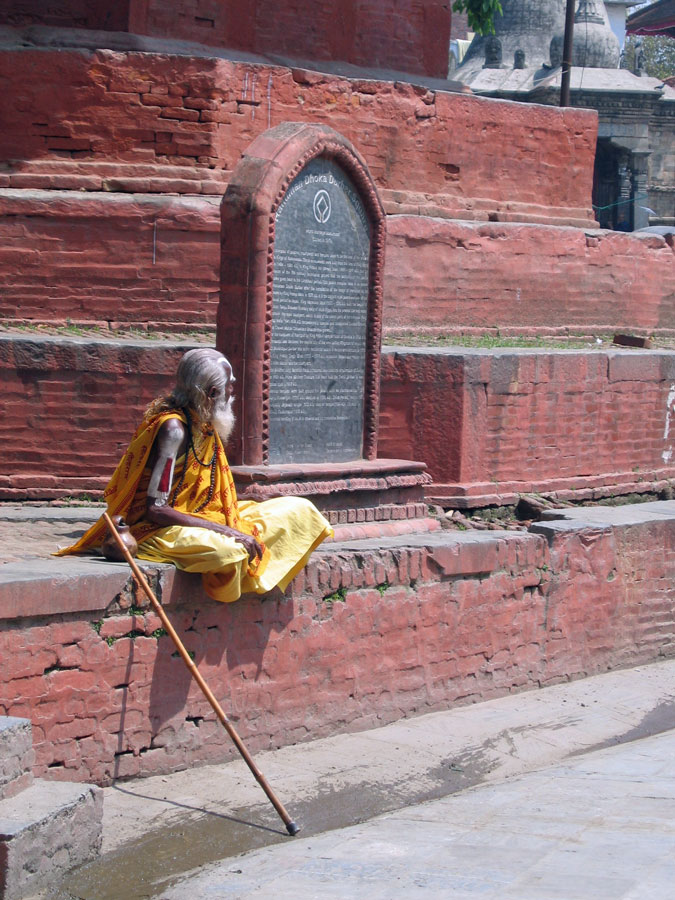
My computer expertise, such as it is, had attracted Dr. Lohani’s interest. He wanted me to teach a short course in WordPerfect: a daunting proposition, since I scarcely knew WordPerfect. But anything is possible in Nepal. I xeroxed a USEF instruction manual and practiced the program on the laptop. I also checked out the computers at the Engineering campus in Patan, the city across the river in Kathmandu. There were 16 working (but under-used) machines, but they had no hard disks and thus could run only WordPerfect 4.2, not the more powerful 5.1 that I was using. I would also need to create a number of disks for the floppy drives. Dr. Lohani, relentlessly cheerful as always, insisted the obstacles would be overcome; furthermore, we would spend a week in Pokhara, 120 miles west, teaching WordPerfect to English teachers from throughout the country. There was no doubt that it could be done, he told me. “Call me Shreedhar,” he added.Just getting to Patan was a small adventure those days, even with the intrepid Balkrishna behind the wheel. The main bridge over the Bagmati River had crumpled some months earlier, probably because so much gravel had been taken from the river bed to feed the anarchic building boom afflicting the area. A detour led to an improvised alternative, laden with traffic during the day. At night it was almost empty but endangered by an attractive female ghost. Her habit was to hitch rides with motorcyclists whom she would terrify by displaying a container full of body parts. Her presence was reported in the newspaper, the Rising Nepal, and taxi drivers were afraid to cross the bridge at night.
Nothing ever seemed routine in Kathmandu, but my life settled into a weekly pattern of sorts: two afternoons for teaching; two mornings for Nepali lessons with Krishna Pradhan. Some Friday evenings I accompanied my Fulbright neighbors Chery Smith and Kay Norton to the American diplomatic compound, Phora Durbar, where a taped Peter Jennings inflicted the weekly news upon us. The experience tended to be uninformative or depressing; I found that the only people who really seemed foreign to me were Americans.
March brought warm weather: from winter to summer in a week. It also brought another computer crisis. One Friday morning files disappeared before my horrified eyes. Yes, it was March 6, Michelangelo’s birthday, but I had been warned of the attack of the worldwide computer virus and had taken precautions. Inadequate ones. Now the machine was deathly ill--but in Nepal there is always an answer. Shreedhar’s son, Debesh, who worked with computers in a local high school, arrived the next morning with his doctor’s bag of virus-killers and substitute WordPerfect files. Within an hour the laptop was restored to (relative) health, although the screen remained skittish the whole time.
And March brought my first--and almost my only--visitors (why didn’t the rest of you drop in?): my colleague from early Nigeria days, Parbati Sircar, and his wife Manjusri flew up from Calcutta, where they then lived. I had hoped to show off my modest language acquisition, but the Sircars’ Hindi was far more useful than my smattering of Nepali. It was Parbati’s first trip to Nepal, but Manju had been there the previous year, with her troupe of classical dancers. She remembered everywhere she had been and what she had paid for everything, to the last rupee. The visit provided a reason for visiting some the numberless temples and shrines, especially Pashupatinath, sprawled along the Bagmati, one of the holiest Hindu temples anywhere. I had been there before, when the place was crowded--frighteningly so--for a major festival. By the river banks, corpses were being cremated over open wood fires, with attendants occasionally scraping in an unburnt arm or leg. Nepal was a Hindu kingdom, the only one in the world, but there is a pervasive Buddhist influence, especially in the north. The concentration of religious art is astonishing.
The Sircars returned to Calcutta April 5--a date I recall because that evening marked the start of a week of strikes, curfews and violence. The democracy movement swept the country in 1990, depriving the king of much of his sweeping authority and producing a prime minister and parliament. The majority party was the Congress, with the Communists (United Marxists Leninists) a strong second. Buildings (including temples) were adorned with old election slogans--"Vote for Cow,” “Vote for Star,” etc. Democracy and prosperity are far from identical; Nepal is one of the poorest countries in the world, with a per capita income of perhaps $175. The literacy rate is 26%. The affluence of parts of the capital (where the Communists ran strongest) has fueled discontent; rising prices, especially for food and electricity, produced an immediate sense of grievance. So about 7:00 p.m. that April evening Buddha came in, with his gentle grin, and turned out all the lights: the protesters had decreed an hour of darkness for the city.
The next day was lovely in a way, and unreal. The motorized traffic that usually polluted the city was gone--except for an occasional police car, nothing moved. Although I saw none of it, bricks were thrown, tear gas tossed and guns fired. At least six casualties scarred the day, with many injuries. The police were, to say the least, undisciplined. In one case they pursued their quarry into a home where they shot a housewife in the leg, shattering it so badly as to require amputation. The victim was a Nepali AID employee well known to several of my friends. Curfews and tension persisted all week, with a Chakka Jam (transport strike) scheduled for the following Tuesday. And then it all ended: no Chakka Jam; everyone returned to normal business. A cynical Nepali friend told me there had been “a deal,” but if so I never learned what it was.
The disturbances coincided with the onset of load-shedding, a familiar phenomenon in countries where the electricity supply has fallen well behind demand. The city was divided into two zones, each of which would be without power on alternate days from 5 to 7 in the evening and from 5 to 10 the following morning. Most of the country’s supply depends on the rivers, and the rivers depend upon the rains. So for news I increasingly relied upon print: the international Herald-Tribune, which I picked up every few days; the Rising Nepal, which Balkrishna bought for me daily, and the Asian editions of Time and Newsweek.
The weather was warming daily. Sometimes it would start to rain and continue raining all monsoon. I was determined to get in a trek before this happened, but my arrangements kept collapsing. Destinations and times never seemed to work out. But finally Kay Norton agreed to accompany me to the Langtang Valley north of the city, the most accessible of all the major trekking areas. She had only about 12 days, squeezed in between the festivals that her enthnographic-musical research required her to attend. Afterwards, I wrote an account on the laptop:
Here at the computer, it is hard to believe that 24 hours earlier I was crawling into my sleeping bag at the Shivapuri Hotel and Restaurant, far less grand than its name suggests, at Pati Bhanjyang. This village of 20 houses lies at 6500 feet, some ten miles north of here, but in a different world. There is no electricity, no hot water but what can be produced on a crude, wood-burning oven. There is, slightly surprisingly, an elementary school, but the secondary school is an hour’s walk away, and the morning there begins at 6:30. Sanitation, as in so much of the country, is not even a word. After nearly two weeks on the trail, I was relieved to be back in Kathmandu, even if the electricity did briefly fail after one of the violent pre-monsoon thunderstorms that have lately struck the city. A warm bath and Shantih’s cooking were never more welcome. We take for granted what millions--billions, I suppose--of people will always lack.
On Sunday April 19, we left Kathmandu in the Toyota, which had lately celebrated its 300,000th kilometer. Balkrishna, of course, driving. Along with him, unexpectedly, was Gopal. Probably Balkrishna wanted company for the return drive, which would take 5-6 hours.
Our first objective, the Langtang Valley, is only about 40 miles north of Kathmandu, but the road is twice that distance, all uphill switchbacks, and only the first half paved. The trip took six occasionally vertiginous hours; lass fortunate trekkers are crammed into a bus for twice that long. Along the way we picked up a police sub-inspector in need of a ride and paid our Park entrance fees--they had more than doubled since last summer, to 650 rupees (the rupee was then worth slightly more than two cents).
We had arrived early enough for Balkrishna and Gopal to return to Kathmandu by dark and for Kay and me to hit the trail. Unlike my excursion to the Everest area in 1989, this venture was unassisted by a trekking company or porters: Kay and I carried all our own gear. Tents and cooking equipment were not included, since we would stop at the now-commonplace lodges along the route; but we were still carrying some 25 pounds each, more than I had undertaken for years. I quickly concluded that I was getting too old for this sort of thing.
Fortunately we were beginning with a half-day; by five o’clock we descended to Syabru, a ridge town with at least 15 competing lodges. We settled on the Hotel Yeti, which proved a mildly upscale version of our boarding for the next couple of weeks. Rooms were private, about 6’ by 8’, with two wooden pallets topped by foam pads. The latrine was standard Asian squat, but with a great view back, if not down. The dining room had a table and a couple of benches, and was quite well illuminated by a gas lantern. The menu was Langtang Park standard, printed black on brown, with only the prices rising with the altitude and distance: apple pancake, pumkin [sic] soup, double cheese omelet... You write down your orders, which the manager is generally unable to read, and pay when you leave. Sleeping charges varied from 5 to 40 rupees a night. Food and lodging together averaged $3 or $4 per person per day.
Organized groups included, there were about 100 trekkers in Syabru. Over the next 10 days we encountered Britons, French, Germans, Australians, Danes, Swiss, a few Asians. No Nepalis, except porters and guides. Israelis are, alas, widely disliked by the lodgekeepers because they quarrel over money, but the only two we met, a pair of young girls, did not fit the profile.
The next day was our first challenge. We dropped more than 1500 feet to the Langtang Khola (river), which we would follow up the valley--going down to head up and the reverse are commonplaces of trekking in Nepal. Thence it was rather steeply up to a suspension bridge, then even more up on the other side of the fast-flowing, glacier-green river. We passed the normal stopping point, Lama Hotel, and carried on another hour and a half to Riverside Lodge at about 2500 meters. Here we slept in a dorm, along with a very young British couple and numerous rats. They (the couple), like many others we encountered, had been touring Asia for some months.
Another hard day brought us to Kyangjin Gompa, at 13,000 feet the last habitation in the Valley. In addition to the Gompa (monastery), it has a Swiss-built cheese factory, a STOL facility where airplanes rarely venture and a number of trekking lodges. We chose the recommended Hotel Yala Peak, which has a separate sleeping building with eight private rooms. The main structure includes the kitchen, a dorm with 20 or more bunks, and a dining room that reminded me of huts in the Swiss Alps. The menu, on the ubiquitous brown sheet, augmented by delicacies like pizza (91 rupees). Since we were higher now, prices had risen, but a big bottle of beer was only 90 rupees--not bad, when you consider that it had to travel several days on someone’s back. The Hotel is supplied by 300 porters carrying loads from the roadhead at Dhunche. Sleeping charges had risen as well--to 40 rupees per person in the private rooms.
We stayed four nights at Kyangjin. The first day we were too tired to do more than wander up the hilly approaches to the Ganja La--a high pass that requires a tent (and at times an ice axe) to negotiate. We were joined by another American, who had a bad cold and was just as tired as we were. The next two days we spent hiking and scrambling up some 5000-meter peaks and walking father up the Valley, just a few miles from Tibet. Daytime temperatures were moderate, but a harsh wind whistled up the Valley. Nights were below freezing, and once we had a brief snowstorm. The dining room was full of the international crowd. The Nepali running the place somehow kept track of all our food orders and at the end presented a bill for 1766 rupees.
Heading down the Valley was a lot faster than going up (though hard on the knees), but our climbing was far from over. First we had to scramble back up to Syabru. Then there was a lot more uphill to our second objective: the sacred lakes at Gosainkund and the pass at Laurebina, which would lead us down toward Kathmandu. We were pushing ourselves to return by Kay’s deadline of May 1, when we stopped for the night above Syabru. The accommodations were a bit downscale, and dogs, chickens and a cow kept wandering in. By this time I was tiring of fried potatoes, omelets and biscuits, as well as of noodle soup breakfasts. Then the storm struck. Later we learned it had hit Kathmandu as well, shattering the many months of placid weather. By morning the reaches above us were bright with snow, and we were told that Laurebina was closed. Nevertheless, hopefully, we resumed our climb, stopping for lunch at a trekking lodge in a hail storm. It didn’t look like clearing, so we there we stayed for a long afternoon and night, preparing for retreat.
But the next morning was unexpectedly clear, so we resumed our upward plod, following the wide trail and bootprints in the snow. Eventually we sidehilled along some quite slippery and precipitous slopes. Heavily-laden porters, some wearing only tattered sneakers and understandably frightened, skidded toward us. By the time we reached the third lake, with its black-rock head of Shiva protruding above the dark waters, the clouds had rolled in over the pass. After the inevitable noodle soup, we climbed up yet again. By now the clouds had closed the visibility to a few hundred feet, and we had to rely mainly on footprints. At one point these became a maze, and we mistakenly headed upon a mountainside. After finally reaching the La, we hurried down into a vast, scarcely-populated valley. Soon we heard voices: a party of some thirty underdressed Nepalis from Kathmandu, struggling upwards on a pilgrimage to the sacred lakes. We urged them on, as it was already nearly afternoon.
We spent that night in our most primitive quarters yet: a single stone hut with no pallets, only mats on the dirt floor. It was run by a woman and her chora (son), aged about seven, who fetched firewood and water in a large, dirty-looking plastic container. (We treated all our drinking water with iodine drops.) After a time we were joined by the Israeli girls and their guide, Ganesh, so there were seven of us in the hut that night. The woman charged 25 rupees per person for sleeping, which was doubtless illegally high (the Park sets limits), but I couldn’t feel indignant after seeing how hard she and her son worked in such desolate conditions.
To save time, we decided on the high, direct trail to the ridge town of Therapati. This is described as “very dangerous when there is any snow,” and there was a fair amount; but the going was innocuous at first. But the clouds rolled back in by 9 a.m., and the trail became steeper and the drop-offs more alarming. At its worst point the footing was very precarious and the consequences of a slip highly disagreeable. It did not feel like a trekker’s path and perhaps had been eroded away. I was contemplating the horrors of a night out, but by 2:30 we made Therapati: just in time for a thunderbolt that jolted to his knees an American on his way up. He and his wife were the first trekkers we had seen all day; partly because of the bad weather, we saw almost none the rest of the trip.
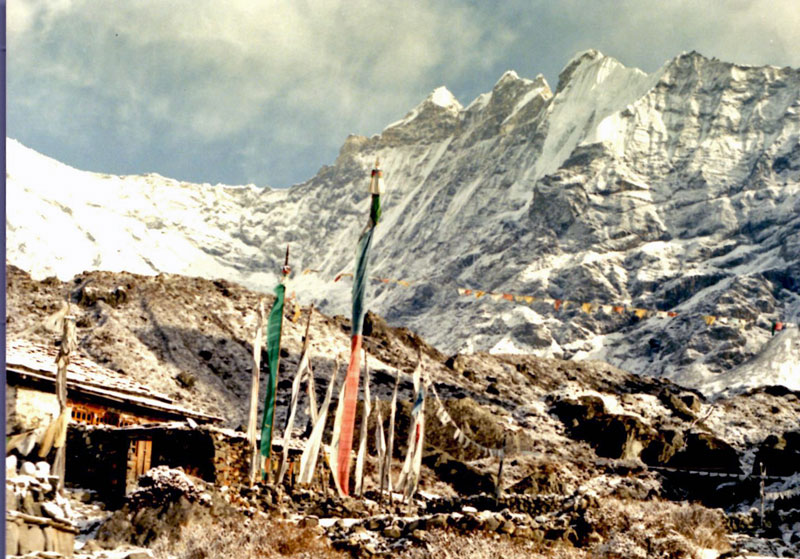
We were now descending toward Kathmandu, but we still had two hard days ahead of us, eight hours on the trail the first one. We spent that final night in Pati Bhanjyang, the only tourists in town. Our hostess was astonished to learn that my cook, Shantih, earned 2500 rupees a month--this seemed quite a fortune to her. At eight p.m. Radio Nepal informed us of the Los Angeles riots. The news was insufficient to keep us in the hills, and we reached the outskirts of Kathmandu--and a pair of competing private taxis--soon after lunch the next day.
I returned a different man. The moment Shreedhar caught sight of me, he said admiringly, “Your paunch is gone.”
The city seemed changed as well; it had become quite cool, with menacing clouds. By afternoon a furious thunderstorm was underway. I thought, and rather hoped, that the monsoon had arrived, but a few days later the weather cleared into a month or more of tranquility. I had still not got to Pokhara; as I had feared, plans for the WordPerfect workshop seemed entirely amorphous. And now that the weather was warm again, I wasn’t even sure that I wanted to go, despite the lake and famed mountain views, for Pokhara is lower and thus hotter than Kathmandu. Both places, however, were chilly compared to places fifty miles south, which were recording temperatures well over 100 degrees.
I had plenty to keep me busy. I made a couple of appearances before the Nepal Literary Association; first to read a poem (probably the only one I will ever write) and then to deliver a paper on minimalism in American fiction. On the second occasion I had trouble getting to the meeting: the police had blocked the roads after students started throwing bricks at oneanother. (Student politics mirror the national dichotomy, and sometimes take similarly violent form.) I also had to prepare a “public lecture,” as it was grandly styled, as was expected of us Fulbright professors. And then, at last, I managed to visit a few undergraduate classes. The literature ones were small; the language ones were big, just as here, only much more so. 75 students or more was typical. The teachers read from English essayists like Forster and Orwell, raising their voices in the echoing amphitheater. The students are sometimes attentive. One of the scandals of the university, readily conceded by the Vice-Chancellor, is the failure of many instructors to teach well or even to appear for their classes. Some of them do, however, hold private tutorial sessions--for a fee. Often the students come from the very University classes that they are not teaching properly. They may charge as much as $9.00 per student per week, which is a great deal to pay and to receive. Faculty salaries, like all official pay in the country, are unrealistically low and encourage such abuses.
My contract was due to expire late June, but an extension into December was suddenly possible. The temptation was great. I have never been so well treated, the country was fascinating, the people gracious, but there were so many contending claims in New York. I did extend the contract, but for only six weeks. There was still much to be done: my public lecture, a possible trip and--to my amazement--the Pokhara WordPerfect workshop. Despite the logistical obstacles and my overwhelming skepticism, it was going to take place.
“Tourist buses” leave for Pokhara at 7 a.m.; “boarding time” is half an hour earlier. I was carrying a heavy load of WordPerfect “mini-manuals” for the workshop, along with my entire wardrobe of socks and underwear. The Chinese and British have considerably improved the road, so that buses often cover its 120 miles in less than seven hours. For my 200 rupees ($4.25), I had a reserved window seat. The other 25 passengers included a British couple and a Japanese woman. The rest looked like Nepalese or in many cases Indians who had headed north in the hot season. Some of the road was still under repair, but the driver was imperturbable (even though the steering wheel was on the left, and clearance with other vehicles often too small to measure). We wound down and out of the Kathmandu valley through green fields and rice paddies. By 2:30 I was in Pokhara; by 3:00 I had reached the Forestry Institute, the site of the workshop.
The campus looked completely lifeless. The gray stone buildings baked under a blue sky, though clouds obscured the promised mountains to the north. At the guest house I found Balkrishna. Unlike my driver of the same name, this one spoke even less English than I did Nepali, so it was hard to know what was happening. I was moved into what looked like a relatively comfortable bedroom, only to be moved out again--indeed, into another building--when there appeared to be no door lock. I was now in the home of the Acting Dean, or the Assistant Dean. He was away, whoever he was, and I had the downstairs bedroom. In addition to its being Saturday, the weekly holiday, the students were away on their extended post-election break.
By foot and by taxi--there are far fewer vehicles than in Kathmandu--I made my way to the town’s most famous attraction, Phewa Tal, a lake several miles around. When the mountains are out, as they still were not, the view is astonishing. For an extravagant 50 rupees, I paddled around in a boat for an hour. It was a cross between a rowboat and a canoe, and took unkindly to my paddling. The Lakeside, as this area is known, is made for the tourists who abound in cooler months, eating at the innumerable restaurants and outfitting themselves for treks in the Annapurnas. Now few remained, Indians excepted. In the taxi at dusk, I glanced leftward and suddenly saw the mountains: the great pyramid of Machupuchure (the fish-tail), sacred and therefore unclimbed, and the five Annapurnas. They were some twenty miles away, and more than five miles up. They looked at once unreal and undeniable.
I discovered that I was not alone in the Dean’s house. Giant Nepali cockroaches were swarming behind the dresser. We left each other in peace, but I would have rather remained ignorant of their presence. The table fan did little to dispel the heat, which may remain my most vivid memory of Pokhara. June of 1984 saw over 30 inches of rainfall, but none fell that night, when I needed it.
In the morning I found someone to take me to the computer lab. It has ten machines, zippy 386s with 40 mg. hard drives. And the place was air-conditioned. We scanned for viruses and installed a few sub-directories. By 10:30 I set off for town--a considerable distance. The 100,000 or so inhabitants have sprawled north-south along the road, and apart from the lakes the place is hardly picturesque. Even walking slowly with open umbrella, I found the going unbearably hot. By the time I had reached a restaurant near lakeside, I was too thirsty to eat much of anything.
Late that afternoon my colleagues, including Dr. Lohani, arrived on the bus from Kathmandu, and I joined them in the guest house. My room was smaller but insect-free. Like most rooms in Pokhara, it had an overhead fan. It also had a western toilet.
I was abruptly introduced to Nepali dietary and eating habits. The general pattern is to begin with dal bhaat at about 9:30 in the morning. This means: a stainless steel plate heaped--really heaped--with rice, accompanied by the dal (crushed lintel) and spicy vegetables. Except for tiffin (tea and snacks) around 1:30, this is the last food you are like to see until about 8:00. And then dal bhaat once more. I found adjustment difficult; after a few days my colleagues took me into town and pointed me to “the best supermarket in Pokhara.” It was more like what we call a grocery store, but I was able to stock up on jam and imported cheese.
The workshop began as scheduled, 10:30 Monday morning. In addition to my four colleagues, there were some others from Kathmandu, quite a few from Pokhara and one from Dharan, 12 hours by bus to the East. Their common characteristic was that they taught English language at one of the science campuses, where they were often disdained by the students for their irrelevance to science. Hence the desirability of an acquaintance with computers.
To summarize the five sessions: from 10:30 till about 5:00, with close to an hour for the tea break in the bleak and stifling cafeteria. I did a lot of WordPerfect, along with Editor, a rudimentary stylistic analysis program that proved very popular. We had two participants to a computer most of the time. Some were very quick, others quite the opposite. I had some assistance from local computer types. Everyone seemed to have a good time of it.
Tuesday night, to my self-confessed relief, I had dinner next door with Mike and Nancy Rechlin. Mike was just finishing two and a half years with an AID forestry project--the one that had supplied the computers. Like so many other Americans, he had been here before, with the Peace Corps in the late sixties. His wife had 6 weeks earlier, in their house, given birth to a large son. They are Christian Scientists and live in the Adirondacks--Mike teaches at Paul Smiths College. Mike’s successor, Tom Hammond, had just driven with Mike from Kathmandu. He is another former Peace Corps volunteer. The dinner was casserole and tuna and pasta salad, a welcome change from the dal bhaat, and I ate a great deal of it.
The next night my four colleagues and I returned to Lakeside for drinks and dinner at a relatively lavish hotel. It was another of those Nepali evenings when you don’t ask questions. The hotel was run by relatives of one of my colleagues. Some money appeared to change hands, but I had nothing to do with it. Afterwards we all five squeezed into a Toyota taxi for the ride back to Forestry.
For reasons only moderately clear to me, Dr. Lohani announced that Thursday night would be spent at Engineering campus, six or so miles north. The students there were on holiday as well, and since the guest house was unavailable we used the student hostels. Rooms have three beds, a dresser, a plain table (not a desk) and a ceiling fan. We had dinner at a colleague’s home. First vegetables and mutton (goat meat); then, it being 8:15 of a Thursday, we adjourned to a nearby television set to watch the Hindi version of the Maharabatra. There are 93 episodes. We were somewhere in the 70s. (The original is 100,000 stanzas.) Things were heating up between the Pandavas and the Kauravas, and war was imminent. Unfortunately the 45 minutes consisted mostly of Hindi talk and dark looks. The patriarch was played by a middle-aged Indian actor decked out in white wig and beard. The series had been an enormous success in Nepal and in India.
After the T.V., it was back for dal bhaat, thence to the hostels. I crawled under my mosquito net. The campus is higher and thus cooler than Forestry, but warm enough. The overhead fan speeded up alarmingly, then stopped. A big thunderstorm ensued, and the power remained off until morning. And speaking of morning.... the head of the English Department at Prithni Narayan (P.N.), the biggest of Pokahara’s campuses (ca. 10,000 students) was a workshop participant. He decided that I should deliver a lecture on American literature. This was happily altered to a brief talk on English-language teaching in the U.S., scheduled for 7:30 a.m. I had the bright idea of pretending that the P.N. teachers were my Brooklyn students, thus dramatizing the differences between our respective methods. The most obvious is that English classes at P.N. have about 135 students each. One workshop participant worked there part-time; he had four sections--540 students. (He had refused the offer of a further four sections.) An elderly teacher wandered in to be terrified to hear me say, “... and I expect you to write at least ten papers for me this term.” He was boundlessly relieved shortly to realize that the requirement was not intended for him.
Following a dal bhaat breakfast we bused back to Forestry. But it appeared, perhaps because Shreedhar et. al. had friends there, that we had moved permanently to Engineering. After a closing ceremony and awarding of participation certificates--including one for me--I packed up again and took the campus bus back to Engineering. More dal bhaat, more rain. Saturday--very hot once the rain stopped--we visited the lakes and other tourist attractions. Sunday my colleagues bused, and I flew, back to Kathmandu. Shantih and Balkrishna met me at the airport. I was back to luxury treatment, and not a moment too soon.
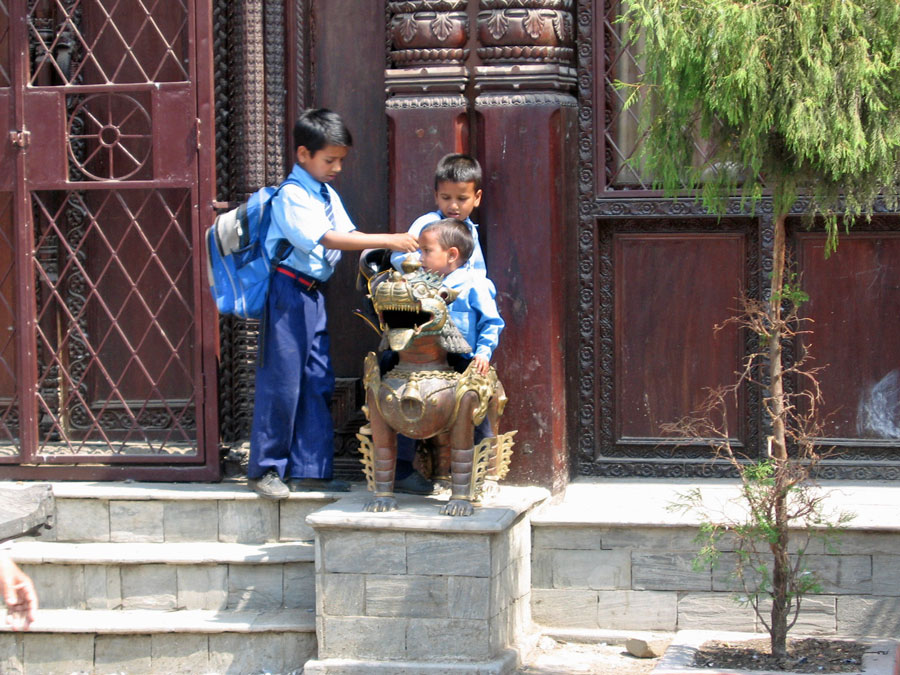
Much still remained to be done. I delivered my public lecture, though it didn’t feel very public: only about 30 people showed up to hear me talk about the turmoil in the American undergraduate curriculum. And then--another trip that I had thought would never take place--I went to Tibet.
There were two ways to reach Lhasa from Kathmandu: by China Southwest Airlines (70 minutes) or by road (3 or 4 days for the 600 miles). We chose to fly in and drive back.
In another sense there was only one way to make the trip: with an organized group. Individual travel was no longer permitted, except through China. (Note: according to the Chinese, who control things, Tibet is a part of China; but few Tibetans would agree.) The tours are expensive, with the travel agencies and Chinese government probably doing very well by them. The first agency we tried wanted $1375 for 10 nights, but we found one, Arniko, that proposed $850 for 9. There were four of us--Gunhild, Amanda, Juliet and I--all teaching in Kathmandu and thus prepared for the uncomfortable and the unexpected. And a good thing too.
Even with travel agents and airplanes, going to Tibet in some way resembles embarking on a trek. You should be in good health and ready for discomfort and surprises. Our flight left virtually on time Tuesday morning, however, and we were soon granted a good view of cloud-flanked Everest to the west. We received the standard red food box: chocolate, a boiled egg, crackers, a bag of taffy, nuts and a can of congee. I opened the latter but left it on the plane after one startling sip--it tastes like sweetened distillate of seaweed. I have, however, retained the Chinese lingzhi pollen extract, which “has actions of preventing senility, Prolonging life, improving health & brightening eyes, nootropic etc.” We were well over cloudy Tibet when we heard the quiet announcement, first in Chinese (I guess), then in English--foul weather precluded a landing in Lhasa. 35 minutes later we were back in Kathmandu.
It was a bizarre day. Along with the other passengers, I was installed at the Yak and Yeti, a genuine luxury hotel about a mile from my house. For the first time in months I could watch television, CNN, BBC, Nepali or Indian. I also took advantage of the delay to visit the (free) U.S. medical clinic for some pills to address the acid stomach that had been tormenting me for a week.
The next morning around 10:00 we did land at Lhasa. Except that it was 12:15 Chinese time. And except that the airport is 60 miles from the city. So by the time our Toyota LandCruiser reached the Yak Hotel it was distinctly afternoon. The Yak Hotel was one reason that our tour was relatively cheap. Most tourists were sent to the Holiday Inn. Yes, Lhasa really had one of those, although some of the key tags say, “This room does not meet the standards of Holiday Inns International.” The standards of the Yak Hotel are more modest. My room had a comfortable bed but no top sheet, just a blanket and quilts. There was a ceiling light but no other. Nor any screens, so I usually shut the windows against the flies. The bathroom at the end of the hall was a reasonably clean tiled squat affair. The hotel doubled as a truck stop, and huge Honda and Mitsubishi monsters were loading and moving around all night. The dogs howled at a pitch that shamed their Kathmandu colleagues. I don’t know what I would have done without my earplugs.
But the Yak had one big advantage--it was right in the center of town (the Holiday is several miles out). The remaining old Tibetan area and the Jokhang, most sacred of the Buddhist temples, are within five minutes’ walk. Unfortunately except for religious sites and the Dalai Lama’s residences, the rest of exotic Lhasa is virtually without interest. It’s just a city of 150,000 people, done in brute Chinese architectural style, if that’s the word. There are thousands of bicycles on the wide dusty streets, some trucks, few cars. It was warm days and most nights, so I discarded the quilts.
We managed to replace the day we had lost, and add another besides. That gave us 5 nights in Lhasa. Our tour price included bed and breakfast, but we had to forage for lunch and supper. Few people, even in restaurants, speak English, and we were fortunate that Amanda knew some Chinese from a year spent in Taiwan. Even so, sometimes we had to venture into a cramped kitchen and point at raw food, with little notion what it would be like when cooked.
We were blessed with the services of an able English-speaking woman guide, Tashi. She accompanied us to the Potala, Norbu Linka (summer palace) and many monasteries. By the time the entire trip was done, our monastery count may have reached a dozen, many with a profusion of temples. Less than a week later, they had melted into a single image of a huge dark room smelling of incense and yak butter, with Buddha and lama statues everywhere, backed by murals on every available inch of space. Experts could spend years in study; for an amateur like me, the impression was overwhelming, indeed stupefying.
Although Tibet seems profuse with monks and monasteries, the number of both is drastically lower than it was 40 years earlier. The Chinese occupation--what else can one call it?--has had calamitous impact on Tibetan religious life. During the worst period, the Cultural Revolution, buildings were used as granaries or blasted to ruins, monks were imprisoned and killed. Their numbers are perhaps one-tenth what they were. Drepung, the biggest monastery, now has some 400 monks; it once had 10,000. The monks are in fact supported--but thus to some degree controlled--by Beijing. Since about 1985, the Chinese government has permitted partial restoration of the monasteries--we saw work at virtually all we visited. But the project will take years, and much art, some of it over a thousand years old, has been destroyed.
Small fees are required for most monasteries; sometimes larger ones if you want to photograph inside. But what the monks (and others) really want is a picture of the Dalai Lama. These you must distribute very covertly indeed: else you may be mobbed by eager Tibetans or fined by a Chinese plainclothesman. The Chinese attitude toward these pictures is very odd. They have been known to confiscate them at customs and even tear them out of guidebooks. Yet they are openly for sale at Lhasa and posted all over the monasteries. Another anomaly, at least for Westerners, is the open display of money in the most sacred recesses of the temples. The delicately poised hand of a Buddha statue may clasp a yuan note; the western toilet once used by the Dalai Lama’s mother at the summer palace is full of coins and bills.
One of our first visits was to the Tserphu monastery, 2 1/2 bumpy hours away in the Yak Hotel LandCruiser. Remoteness is no obstacle to religion in Tibet. A new lama had just been discovered and installed, a boy eight years old. He appeared as promised, promptly at two that afternoon, waving composedly from a high balcony. Incidentally, Tibetan children, like Tibetans in general, are far more aggressive than their Nepali counterparts. They tend to grab you by the arm: “Hello, money.” “Hello, how much?”
After five days in Lhasa we were getting used to the altitude. At about 12,000 feet, it was virtually the lowest place we would stay. Early Monday morning the LandCruiser rolled out of the city. Unfortunately, Tashi had to remain. In her place was Pemba, a very amiable Tibetan who spoke moderate English and knew little of the sites we would be visiting. The driver, Garma, also Tibetan, spoke no English at all. We backtracked past the airport and embarked (minus the car) on a large wooden outboard ferry across the Bhramaputra River. It is very wide and full of mud flats, so the crossing took more than an hour. On the other side, we boarded a tractor cart for a very bumpy 45 minutes to the Samye monastery. Here, as elsewhere, we saw many paintings and statues and almost no other tourists.
The next two nights were spent in the small city of Tsedang. The hotel at first astonished me: after the Yak, it was pure luxury. Each room had two beds, a bathroom with hot water (at least some of the time) and a phone. This was the pattern of the Chinese-built accommodations we used all the way to the Nepal border, though they became shabbier as we moved on. The buildings were pure Cell-Block-H design--cold and entirely without appeal. The “Notice to Guests” at Tsedang was severe: “Any guest or visitor who behaves in a noisy or disorderly manner, e.g. drunkeness, fighting, disturb phoning or threatening the safety of others, will be guilty of an offense. Our hotel will deal with them in a serious way.” Furthermore, “inflammable goods, explosives, poisonous and radioactive materials are forbidden in the hotel. Guests with guns and ammunition must register with our Security Department.”
In the morning we headed for Yongbulagong, perched on a sharp hilltop south of city and said to be one of the oldest buildings in Tibet. When we lurched to a halt at one of the narrowest switchbacks, Amanda jumped out with a yelp. Silly girl. We spent an hour or so at the dramatic site, then headed back for Tsedang. Tibet drives right, but we were careening on the left. So was the Chinese army truck rushing towards us. Both drivers swerved, but neither braked. The truck caught us amidships. Nobody was hurt or even noticeably shaken up, and the truck suffered only a dented fender, but the left side of the LandCruiser was a mess. I was sure that our driver would be detained, that we would have to go back to Lhasa and be unable to return to Nepal for weeks. While my companions headed for yet another monastery and the driver and guide went in search of police, I stayed with the vehicle. The accident had attracted a small crowd; some seemed just as fascinated by the LandCruiser and contents as by the crash itself. The truck driver, who looked no more than 18, assumed a squatting position by his vehicle and did not move an inch until the police arrived, more than an hour later. His wife or girlfriend remained in the front seat; she had the most terrified expression I have ever seen.
My worst fears did not eventuate: the driver was not detained, and the vehicle, despite its smashed left doors, was able to function. But the driver and guide had to reappear before the police ten days later. I will never know what happened, but they were Tibetan while the police and army were Chinese.
From Tsedang we began the long overland journey to Kathmandu. The first stop was Gyantse, 200 miles west. Leaving the last of our paved roads, we climbed for an hour to the Khamba La (pass]) whence we had an enormous view of the crab-shaped turquoise lake, Yamdrok Tso. This body of water is sacred top the Tibetans, who do not boat on it or swim in it. The Chinese are planning to use it for a hydro-electric project.
Gyantse, with a population of some 10,000, was the most authentically Tibetan town that we saw. It is dominated by a hilltop fort, attacked by the British in 1904, and by the Kumbum, a nine-leveled pagoda said to contain 100,000 images. The next day brought us to Shigatse, the country’s second city (population 40,000) and yet another chilly Chinese hotel. Our next and last night was at the isolated Xegar checkpoint, about 14,000 feet. The hotel was the most unwelcoming yet, despite some attempts at hospitality. We rose early for a typical breakfast: tea and coffee, jam (no butter), rolls, salty and greasy eggs, a rice soup, peanuts. Then it was up over a long, gradual pass with a sudden dramatic view of Shishapangma, the only 8000-meter peak entirely in Tibet. On a cloudless day we could have seen Everest and many others.
Now it was down thousands and thousands of feet; the brown and barren hills melted into green forest. We were in a deep valley, full of monsoon-fed waterfalls. This was Zhangmu, the last stop for the LandCruiser. We passed Chinese customs and immigration and looked for the Arniko vehicle that would carry us to Kathmandu. There was no vehicle of any kind, so we picked up some porters--no problem, that--and headed down the 6 miles to Friendship Bridge, the true border. With shortcuts we made the trip in an hour, but still found no one from Arniko. So, in a combination of Chinese, Nepali, and English we bargained with the porters and paid them. And waited. And... in brief: Arniko had expected us as originally planned, two days earlier, and it was mostly luck that anyone at all from the agency showed up. We boarded a private bus and settled into the trip down the spectacular valley. But not for long: the previous evening a landslide had obstructed the road (no injuries), and there was nothing for it but to scramble down to the river and walk a while more. On the far side of the slide there was another bus--again a private one, but it stopped when it had to (at least 5 army or police check-points, much worse than Tibet) and when it didn’t: for food and beer. We reached Kathmandu about 8:45, but that was 11:00 p.m. Tibet time, and we had been up since 6:00.
It was a relief to be back in a developed country.
It was now mid-July; to my great regret, my stay was nearly over. I made a last round of shrines, wandered for the last times through the Kathmandu bazaars and embarked on a number of farewell visits and ceremonies. I gave a dinner for the marvelous USEF staff, minus Penny, who had departed on leave. I was invited to several Nepali homes. The American Literature group took me to a ceremonial restaurant dinner, where I was given a beautiful wool sweater, and where I made the inevitable speech, with a sentence or two in Nepali. One of the occasions I had most eagerly anticipated was my Fulbright farewell at the home of the head of USIS. I was able to add all my friends to the guest list. But toward the end, an ominous rumor begin circulating, like some insidious fog: the plane from Bangkok, due at 12:55, had vanished. Maybe it had been diverted to Calcutta because of the rain. But it was now past 7:00. Thai Airways is very reliable; like most of my friends, I had taken the flight from Bangkok, scheduled four times a week. No international flight had ever gone down in Nepal. But the next morning the plane had not been found. And the morning after that my student, Jyoti Shrestha, interrupted her reading of the 8:00 a.m. news in English to announce that the wreckage had been spotted.
The crash site was north of the city--and anyone who has been there knows that north means up. The crash site was close to the desolate region where Kay and I had trekked on our descent from Gosainkund. The pilot was very experienced, but quite new to this route. Perhaps the control tower had directed him in the wrong direction in heavy rain. I don’t know whether the mystery was ever solved. There were no survivors: the pilot, expecting to land at Kathmandu, had nosed into a steep hillside. The biggest fragment of the wreck was less then ten feet long. The passenger list was predictably multi-national, and it seemed that half my friends in Kathmandu had known someone aboard. Among the American casualties were a family of seven and a Peace Corps volunteer. The disaster soon lost its uniqueness: two months later a Pakistani flight from Karachi went down on the approach to Kathmandu, and again there were no survivors.
Five days later I was at the airport, waiting for the Thai airplane to arrive at 12:55. It came, on time and full. The flight to Thailand was not tranquil, however. I was sitting next to a Gurhka soldier, stationed in Indonesia, who harangued me for an hour about the end of the world, which he expected by the close of the decade. But when the plane was apparently struck by lightning, he grew strangely silent. When we landed, the entire nervous planeload broke into applause.
The next day I was back in New York, suffering culture shock. I have missed Nepal ever since.
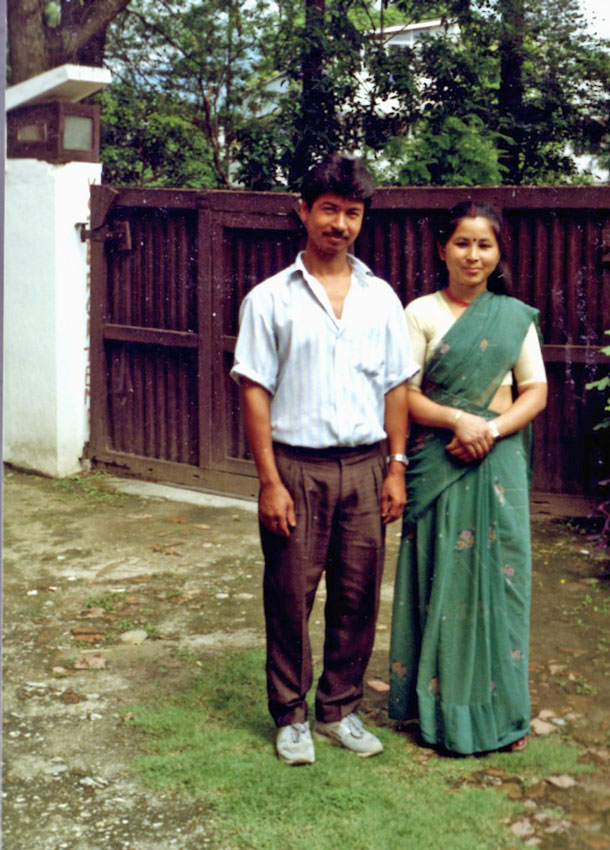
Addendum:One day I was invited to present a poem to the local literary society. I had never written one of these, but I came up with the following (eventually published in Himal, May/June 1992). Note: “Fair throughout the Kingdom” is what you heard all the time on Radio Nepal, except during the monsoon.
"The Day Kathmandu Disappeared"
His expectations betrayed, the pilot,
Amazed,
Pulls up the nose of his jet.
It was there yesterday.
Miles of haze fill the valley.
The lower he goes, the thicker it gets.
There is no bottom.
Where his instruments demand a city,
He can find only miasma.
He banks, dipping a wing into the murk,
And flies his puzzled passengers back to Calcutta.
Beneath, invisible, the city goes about its business
Brick is slapped upon brick.
The diminished Bagmati struggles through silt.
An army of tempos roars staggering from Ratna Park,
And buses lurch belching up Lazimpat.
It is a day like any other.
But there are no airplanes.
The inverted bowl of the sky reveals no mountains,
No outline of forested hills.
The city has become what it is,
Poisoned and inviolate.
Radio Nepal reports:
Fair throughout the kingdom.
